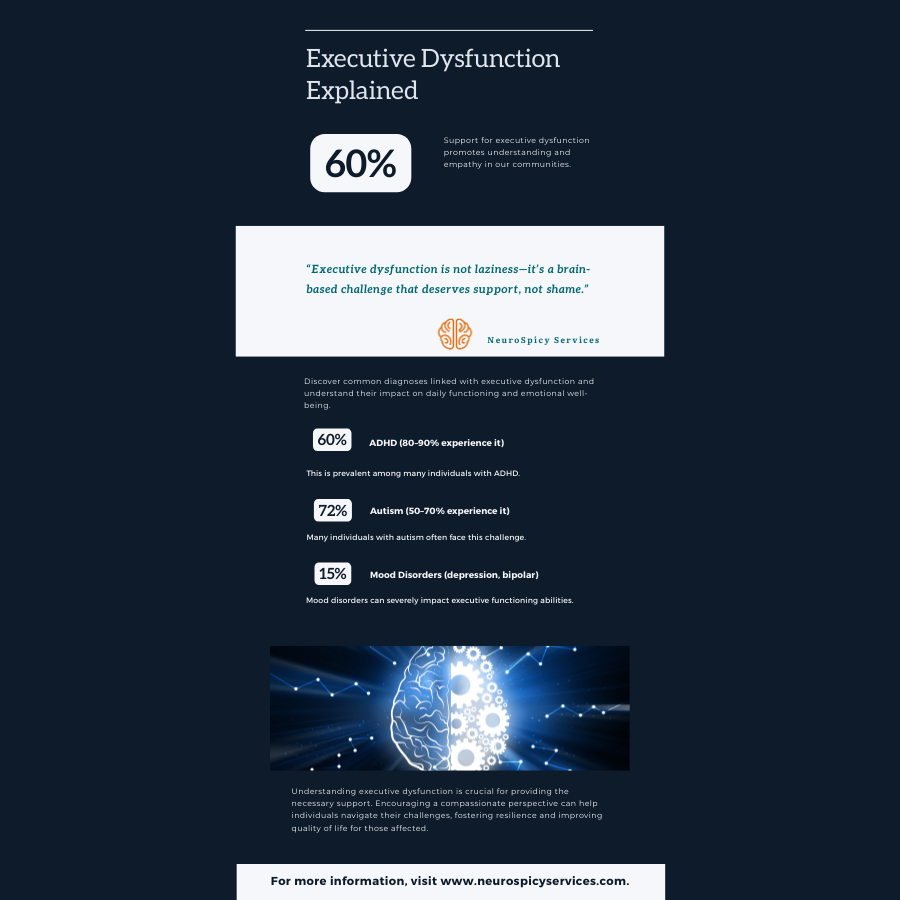When Laundry Feels Like a Mountain: Living with Executive Dysfunction
This past weekend, I had a panic attack over laundry.
The piles felt I was standing at the base of Mount Everest, and I stood frozen, unable to start. What might look like procrastination to someone else was, for me, executive dysfunction at its peak. I’ve learned to find humor where I once felt shame, but in that moment, all I felt was stuck.
Executive dysfunction is one of those invisible challenges that can shape daily life in ways most people don’t see. On the outside, it can look like forgetfulness or avoidance. On the inside, tasks like laundry feel like staring up at a mountain—unsure how to get started, while others seem to breeze ahead.
And it’s far more common than most realize. Research shows that about 50% of children with ADHD show clear executive function deficits when tested individually. A broader meta-analysis reports that 21% to 60% of pediatric ADHD cases involve executive dysfunction depending on the measures used. In autism spectrum disorder (ASD), studies consistently identify executive dysfunction as a core challenge, with adults often continuing to experience persistent difficulties in working memory, shifting, and fluency. Even neurotypical adults report lapses in initiation, planning, or memory when under stress or exhaustion. We don’t grow out of it.
These struggles with ordinary tasks become a window into how differently our brains manage daily life—and why compassion matters.
For someone with executive dysfunction, the same scenario plays out differently:
Task initiation stalls: The thought “I need to do laundry” lingers for hours or days. The gap between intention and action feels impossible to bridge.
Time becomes foggy: Estimating how long it will take feels overwhelming. Starting might risk missing something else.
Working memory falters: By the time the clothes are in the washer, the detergent may be forgotten. Or the clothes sit in the machine for days. In my case, piles of clean laundry often live on the couch.
Emotional regulation spirals: Instead of a small hiccup, interruptions bring frustration, shame, or shutdown.
From the outside, this can look like procrastination or laziness. But beneath the surface is a brain navigating hidden barriers. When executive dysfunction collides with outside expectations, whether from employers, family, or our own inner critic, it often sparks thoughts like:
“Why can’t I just do this?”
“Everyone else seems to manage.”
“I’m failing at the simplest things.”
These thoughts trap us in a cycle where shame makes initiation even harder. Judgment from others, even subtle, fuels the loop and can leave neurodivergent people feeling broken and powerless to change.
This is where self-compassion can make a difference. Instead of judgment, it offers care and curiosity:
“My brain works differently. What support do I need right now?”
“This is hard for me, and hard doesn’t mean impossible.”
“I am worthy of kindness, even when I struggle.”
Self-compassion interrupts the spiral by replacing shame with understanding. It creates space to experiment with strategies such as timers, body doubling, or sensory breaks, without the added weight of self-criticism.
I still struggle with executive function. But I’ve learned that naming the difference strips away stigma. Where judgment narrows options, self-compassion opens them. When we treat ourselves with the same patience we’d offer a friend, we’re not excusing the challenge—we’re building resilience and giving ourselves room to discover supports that actually work.
Living with executive dysfunction doesn’t mean living without hope. When we meet ourselves with curiosity and compassion, we create the conditions to try new approaches, laugh at the missteps, and celebrate small wins. Each act of self-kindness builds resilience, making space for strategies that actually work for our unique brains. What starts with laundry, or any everyday task, can become a powerful practice in changing how we relate to ourselves.
Further Reading
Willcutt et al. (2005) – A large review showing that many, but not all, children with ADHD experience executive function challenges, highlighting how common these struggles are. Read here
Kofler et al. (2018) – A meta-analysis finding that between 21% and 60% of children with ADHD have executive dysfunction, depending on how it’s measured. Read here
Craig et al. (2016) – A review confirming that executive dysfunction is a shared trait across both ADHD and autism spectrum disorders. Read here
Demetriou et al. (2019) – A study mapping how executive dysfunction shows up in autistic people across the lifespan, affecting memory, flexibility, and fluency. Read here


